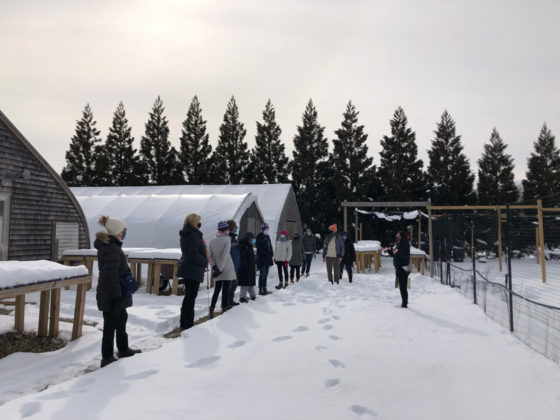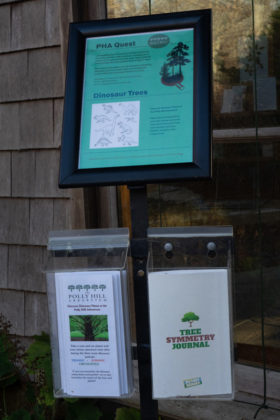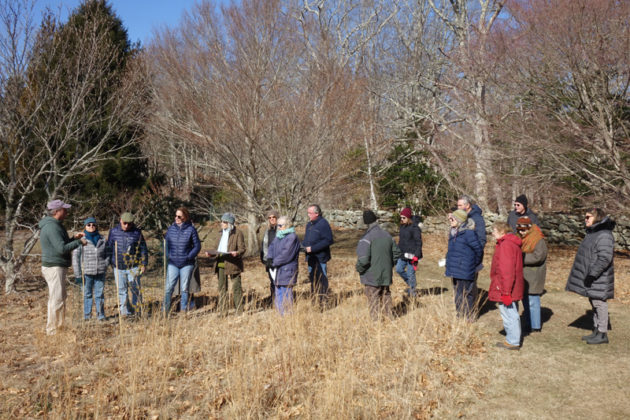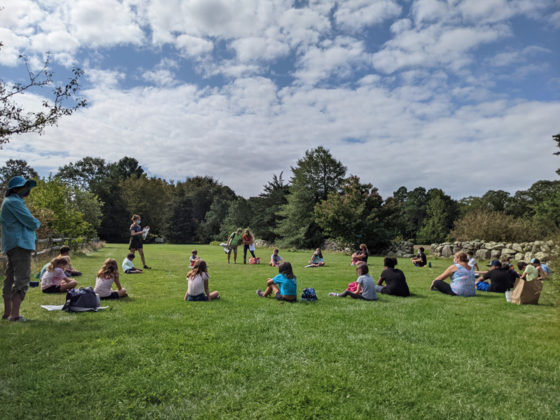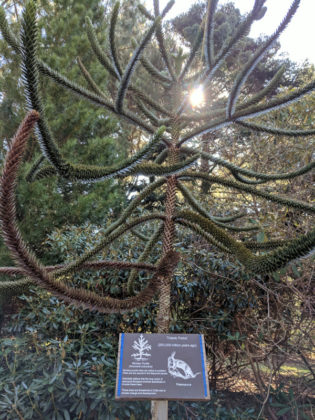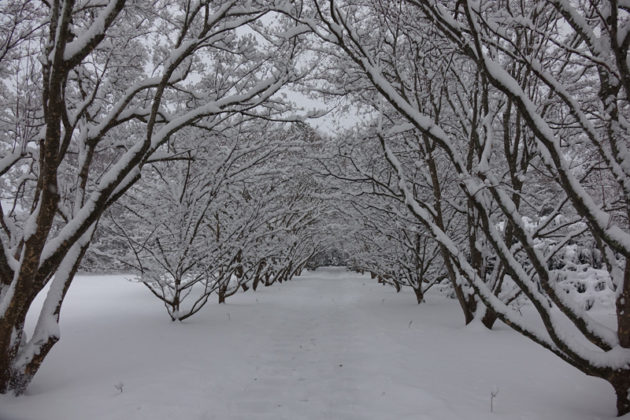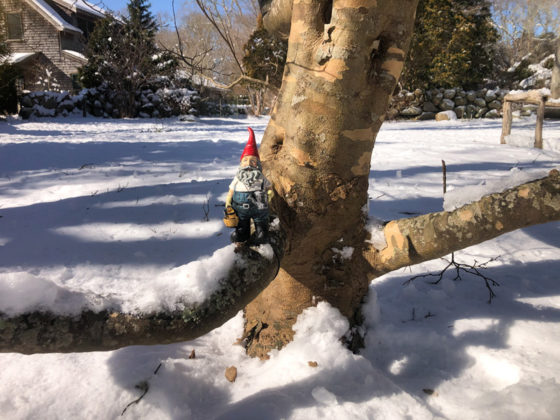Polly Hill Arboretum offers a wealth of information and intrigue for those passionate about plants and the outdoors, but the sprawling grounds are also a perfect place to walk about and enjoy a relaxing day with family and friends.
The arboretum, located in West Tisbury, is open daily, year-round, sunrise to sunset.
Make sure before you head to Polly Hill that you check the website pollyhillarboretum.org for notices about occasional closures due to weather or maintenance.
Want to access some hands-on materials that help inform you about the offerings while you tour the campus? Stop by the visitors center, open mid-May through mid-October.
Parking is free, admission is $5, and is free for Polly Hill members and children 12 and under.
The grounds are wheelchair accessible, but not paved. Certain areas have uneven ground, mulch, roots, and other terrain that could cause difficulty navigating with a wheelchair. No dogs are allowed on the grounds.
Don’t feel like following a tour guide or have limited time to take in all the scenery? Grab a map brochure and take a self-guided tour. The brochure also includes information about the arboretum’s founder, Polly Hill, tips on reading plant labels, plant and location highlights, and other visitor information.
Benches are situated at picturesque locations throughout the grounds that provide spots for rest and plenty of time to take in the view.
These self-guided tours change based on the season, and are often based on a fun theme or type of plant.
A winter tree ID booklet is available in the brochure boxes outside the visitor center for anyone looking for help identifying trees native to Martha’s Vineyard in the winter by their bark, needles, and other traits.
Another great self-guided option (perfect for kids and families) is the Gnome Hunt, which will be returning this off-season. Garden gnomes will be hidden throughout the campus and a scavenger hunt map will be available in the brochure box. The gnomes will be spread around the grounds through the month of March.
There are many opportunities available at Polly Hill during the off-season that are both enriching and enjoyable. Staff-led Winter Walks are held the second Saturday of each month, December through March, from 10 to 11 am.
Each tour has a specific focus on certain winter plants that have unique and beautiful foliage, color, textures, structures, cones, and berries. For example, Polly Hill director, Tim Boland, will lead a Winter Walk focused on witch hazels, most of which bloom in late winter. Winter Walks are free with $5 arboretum admission, and totally free for members.
On Saturday, Jan. 29 and Feb. 26, from 10 to 11 am, visitors can immerse themselves in nature with a traditional Japanese practice of Forest Bathing, or Shinrin-Yoku. Arboretum staff will guide you through an hour-long mindful walk through the trees. This kind of meditation has been shown to improve immune response, mental performance, and creativity.
The instructor, Shanta Gabriel, has worked in the field of alternative health for 40 years, and has been leading groups in nature since 2012. Forest Bathing is $10 for members and $15 for nonmembers.
Also on occasional Saturdays, including on Feb. 19th, from 10 am to 12 pm, the arboretum will hold a Winter Tree ID class, led by ground manager and arborist Ian Jochems. The class will help participants learn how to identify Island trees in the winter based on key characteristics such as their bark, twigs, needles, fruit, and more. The class is $20 for members and $35 for non-members.
Although the arboretum doesn’t have specific dates for their webinars quite yet, they have at least one webinar each month, January through March. One webinar currently in the works is structured around native plant-related topics, all leading up to the opening of the new Native Tree Trail this spring.
Additionally, Boland and Liz Thomas (plant recorder) will compile a travel log on their seed collecting trip earlier this fall to the American Southeast. Past webinars are also available on the Polly Hill YouTube channel, including Boland’s webinar from last winter on witch hazels. Just search Polly Hill Arboretum on YouTube to find the channel.
What to watch for
Over 50 different types of hollies are grown at the arboretum, including several forms of American holly and winterberry selected by Polly Hill for superior characteristics such as fruit color and foliage.
Bark stands out more visibly in winter, including the color variations between bark on the trunk, branches, and limbs. Trees show off their wide array of bark textures and shades. Highlights: The paperbark maple, endangered in its native China, has exfoliating bark that peels off in colorful curls and glows when it catches sunlight. Polly Hill Arboretum is the National Collection holder for stewartias, a group of trees native to East Asia and North America.
PHA hosts a diverse conifer collection that offers year-found greenery in every color, shape, and texture. In her day, Polly Hill planted dense rows of conifers parallel to the fenced garden on the south end of the grounds known as Polly’s Playpen.
There are also a variety of broad-leaved evergreens with leaves that hang on during winter’s chilly weather. Broad-leaved evergreen rhododendrons: The well-drained, acidic soil of the Arboretum supports the successful growth of hundreds of species, cultivars, and hybrids of rhododendrons and azaleas, mostly originating in temperate regions of North America and Eastern Asia. The broad-leaved evergreen rhododendrons are especially noteworthy in the offseason. As their common name suggests, these generally medium to large shrubs are clad throughout the year with leathery, glossy, evergreen leaves. Flip over the leaves, and on some species and hybrids, you will find they are cloaked in a soft, fuzzy coating known as indumentum.
Fall colors at the arboretum tend to be more intense and longer lasting than on the rest of the Island due to the diversity of deciduous trees growing. Fall through spring is also a great time to view the meadows, which have been maintained as fields since the days when the Arboretum was a sheep farm in the early 1900s. The gold and amber hued grasses ripple in the wind, and the historic stone walls encircling them create a peaceful agrarian scene.
Check out Polly Hill’s Instagram photos for seasonal plant highlights @pollyhillarboretum
Registration for all of our programs is required. To register, visit the arboretum website pollyhillarboretum.org and navigate to the programs calendar. There may be additional programs added soon. People can also subscribe to the Polly Hill email list for program updates at bit.ly/phasubscribe.

